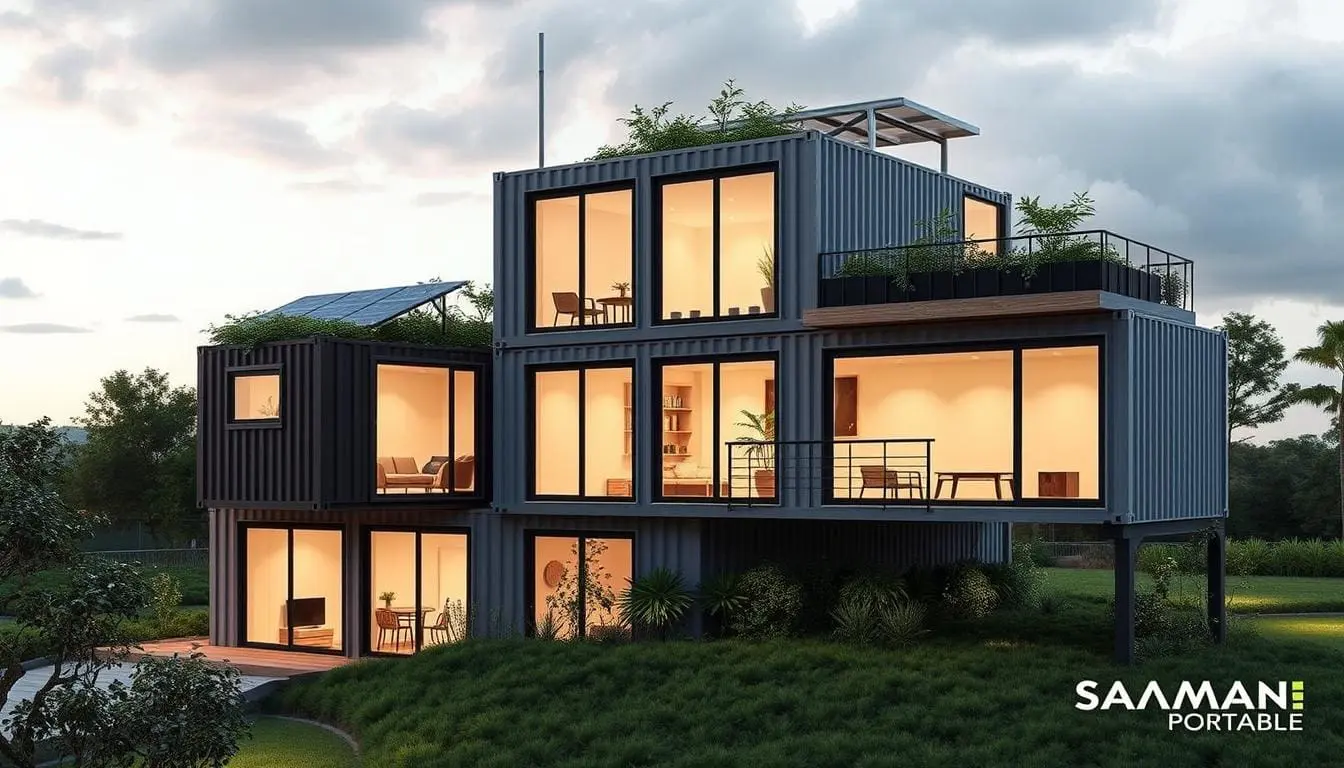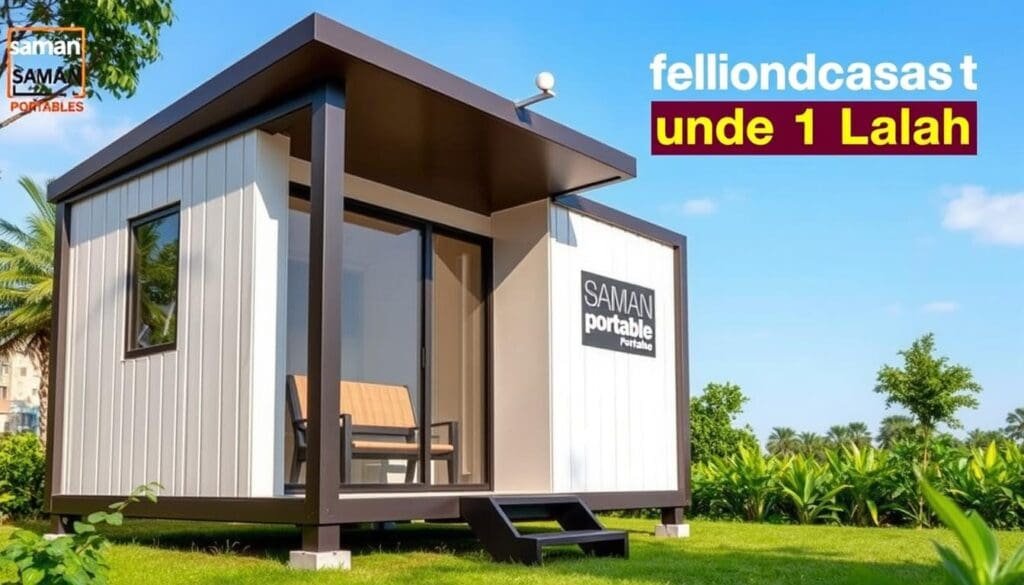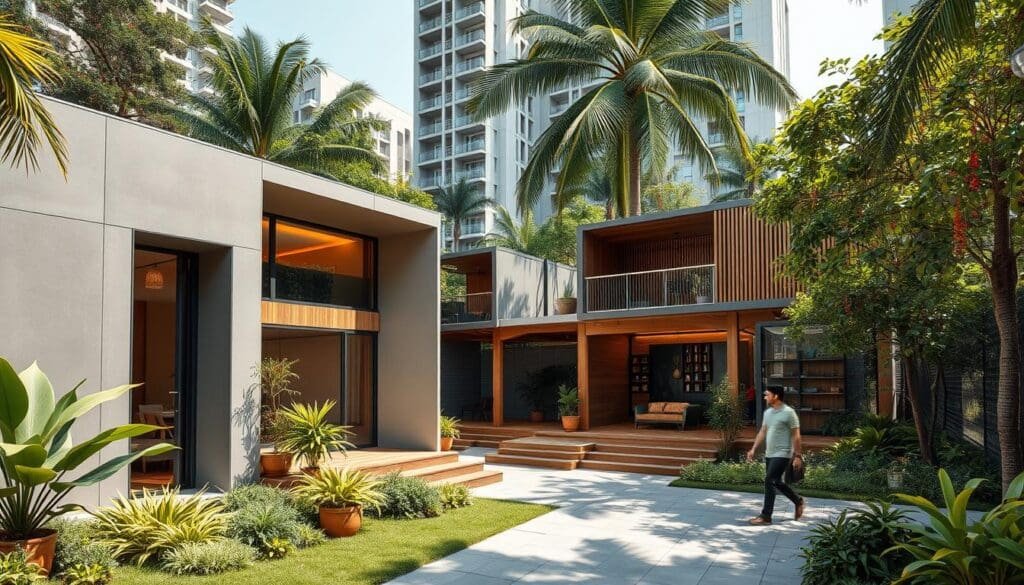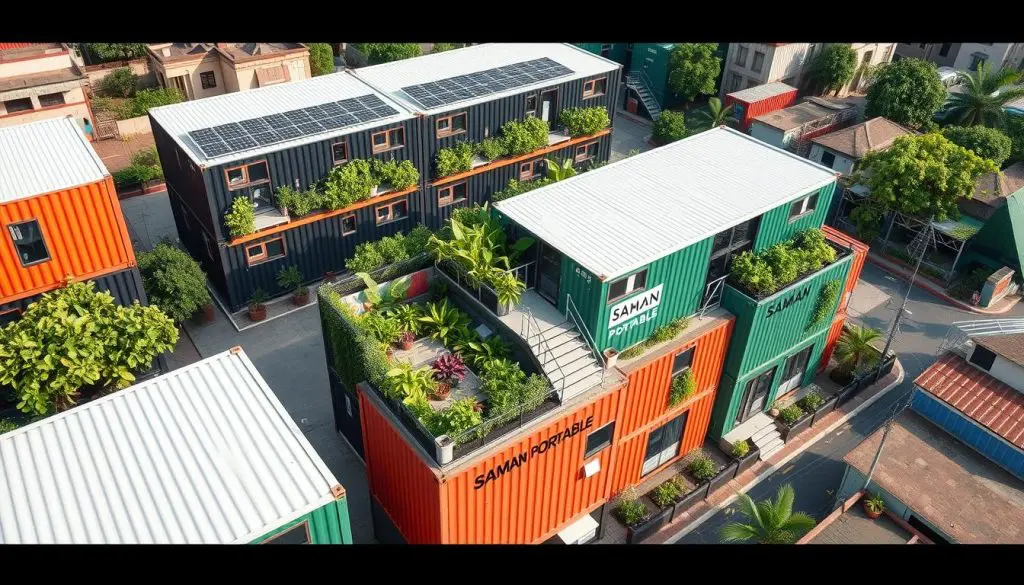Shipping Container Building Plans: Your Guide to Efficient and Affordable Construction

Housing costs and sustainability are big issues today. Shipping container homes offer a fresh, affordable solution. Can these steel containers turn into your dream home?
The market for shipping container homes is booming, set to hit $73,070,500 by 2025. They’re not just cheap; they’re also good for the planet. This guide will help you understand shipping container building plans. You’ll learn how to make the most of this amazing material.
Key Takeaways
- Shipping container homes offer an affordable and sustainable alternative to traditional housing.
- The global shipping container homes market is projected to reach $73,070,500 by 2025, indicating strong growth in this sector.
- Used shipping containers can be purchased for as low as $2,500, providing a cost-effective building material.
- Customizable design options and the ability to combine multiple containers allow for a wide range of floor plans and layouts, like customizable shipping container homes.
- Integrating sustainable features, such as solar energy and efficient insulation, can significantly reduce the overall cost of a container home, as seen in prefabricated modular homes.
Understanding Container Home Fundamentals
Shipping container homes are becoming popular for their cost and sustainability. They use old shipping containers, which are good for the planet and save money. This appeals to people who care about the environment and like to DIY.
Benefits of Container Construction
- Cost-effectiveness: Shipping container homes are cheaper than traditional houses. They can cost under $50,000, which is much less than the average house price in 2022.
- Quick construction: Building a container home is faster than building a regular house. This is because the main structure is already there.
- Modularity: Containers can be stacked and connected to make unique homes, such as modular office containers. This makes it easy to create different layouts.
- Durability: Shipping containers are built to last. They can handle tough weather, keeping your home strong.
- Environmental benefits: Using containers for homes is good for the planet. It reduces waste and supports green building.
Types of Shipping Containers Available
The most common sizes for container homes are 20-foot and 40-foot. These sizes give about 320 and 640 square feet of space. High-cube containers are taller, offering more space for lofts and other vertical designs.
Cost Considerations and Budget Planning
When planning a container home, think about the cost of the containers, site prep, and finishing touches. Used containers are cheaper, costing between $3,000 and $4,500. Remember to include the cost of utilities, insulation, and meeting local building codes in your budget.
| Container Size | Approximate Living Space | Estimated Cost (New) | Estimated Cost (Used) |
|---|---|---|---|
| 20-foot standard | 320 sq ft | $4,500 | $3,000 |
| 40-foot standard | 640 sq ft | $5,500 | $4,000 |
| 40-foot high-cube | 688 sq ft | $6,000 | $4,500 |

Market Growth and Sustainability Impact
The global shipping container homes market is expected to grow a lot in the next few years, emphasizing cost-effective container architecture. Experts predict it will jump from $44,768,600 in 2017 to $73,070,500 by 2025. This increase is because more people want affordable and green homes.
Shipping container homes are good for the environment. They use up to 90% recyclable materials. This makes them a popular choice for those who care about the planet.
The Asia Pacific region is leading the market with 47.13% in 2024. China is handling the most cargo. North America is also growing fast, with a 6.15% CAGR in 2024. This shows how sustainable container designs are loved worldwide.
Shipping container homes are a smart solution for many problems. They offer a green and affordable way to build homes, similar to our affordable container houses. As the world faces issues like urbanization and housing shortages, these homes are a bright spot.

Essential Building Permits and Legal Requirements
Building a container house involves a lot of rules and paperwork. Before starting, you need to know the key permits and laws in your area.
Zoning Regulations and Building Codes
Container homes are legal in some places but not others. Texas and Louisiana are more open, while California is stricter. You must check the local laws and codes to follow them.
Things like earthquake safety, wind resistance, and how many containers you can have matter. These rules affect your design and building steps.
Required Documentation
- Detailed floor plans and structural calculations
- Proof of ownership or lease agreement for the land
- Permits for utilities, such as electricity, water, and sewage
- Environmental impact assessments, if required
- Architectural and engineering drawings, stamped by licensed professionals
Professional Certifications Needed
For complex designs, you should hire skilled architects and engineers. They make sure your home meets all safety and building codes. Their expertise and licenses are often needed for permits.
| State | Regulatory Landscape | Key Considerations |
|---|---|---|
| California | Strict building codes and regulations, including seismic standards | Detailed plans and certifications required |
| Texas | Relatively more flexible regulations, especially in rural areas | Focus on compliance with local building codes |
| Florida | Emphasis on wind load requirements due to hurricane risks | Specific construction standards for safety and resilience |
Understanding the legal side of container house plans is key. Knowing the zoning laws, building codes, and needed documents helps your project meet local standards. This increases your chances of a successful build.

Shipping Container Building Plans: Design and Layout Options
Building a home from shipping containers offers endless design and layout options. You can create anything from a single-container home to a large complex. Using tools like SketchUp or Planner5D makes planning your container home layouts easy.
Maximizing space is key in container home design. Adding features like built-in storage and multi-functional areas helps use space well. Modular designs also make it easy to expand or change your home as needed.
Shipping containers come in standard sizes, 20 feet and 40 feet. You can combine these to create unique, striking structures. Designers often stack, stagger, or angle containers for dynamic looks.
| Container Size | Interior Space | Typical Uses |
|---|---|---|
| 20 ft | 160 sq ft | Tiny homes, backyard offices, guest suites |
| 40 ft | 320 sq ft | Single-family homes, multi-unit complexes, commercial spaces |
Shipping containers’ limited height can be a challenge. But, designers use large windows and smart roof designs to make spaces feel open and bright. You can choose from flat, gabled, or shed roofs to affect the look and function of your home.

By using shipping containers creatively, you can build amazing, sustainable homes. Whether you want a cozy retreat or a big, multi-story house, the design options are endless.
Site Selection and Foundation Preparation
Finding the right spot and building a strong foundation are key to a good modular building plan. The first step is to check the ground to make sure it can hold the weight of the containers.
Ground Assessment Methods
Geotechnical engineers are crucial in this step. They test the soil to see if it can bear the weight of the structure. They look at soil density, cohesion, and moisture to decide if the site is good.
The Unified Soil Classification System (UCS) helps sort soil types. Building codes like the International Residential Code (IRC) and International Building Code (IBC) give values for different soils.
Foundation Types and Installation
Modular buildings can have temporary, semi-permanent, or permanent foundations. Temporary ones like wood beams or gravel are good for short-term use. But, semi-permanent and permanent foundations last longer and are more stable.
For long-term safety, concrete slabs or piers are often the best choice. They ensure the containers stay secure over time.
Drainage Solutions
Drainage is key to keep water away from the building. Grading the site, using French drains, or other solutions can help. This prevents water damage and keeps the foundation dry.
| Foundation Type | Advantages | Disadvantages |
|---|---|---|
| Temporary |
|
|
| Semi-permanent |
|
|
| Permanent |
|
|

Container Modification Techniques
The market for modifying containers has grown a lot, reaching USD 85.3 billion in 2022. It’s expected to hit USD 147.6 billion by 2030, with a 7.1% growth rate. This growth comes from more demand for modular structures and container architecture. People also want to live in a more eco-friendly way.
To turn shipping containers into homes, many techniques are used. Tools like plasma cutters and angle grinders help make windows and doors. It’s important to make these openings strong to keep the container safe.
After cutting, the inside is framed with metal or wood. This is where insulation and finishes go. Spray foam insulation keeps the temperature right and makes it quiet.
- Insulation, typically spray foam, is installed to regulate temperature and reduce noise levels, ensuring a comfortable living environment.
- Pre-fabricated windows and doors are then carefully installed, with proper sealing to prevent air and water leaks.
The building and construction sector is leading in container modifications. This is because of the need for affordable, green homes. North America, especially Arizona, California, and New York, is at the forefront of these projects.

Shipping containers are versatile and used for many things. They’re great for homes, offices, shops, and even disaster shelters. By using these strong steel structures, we can live in a more sustainable and cost-effective way.
Structural Reinforcement and Support Systems
When designing modular buildings from shipping containers, it’s key to focus on the structure’s support. Working with structural engineers is vital, especially for multi-container designs. They help with load calculations and figuring out needed reinforcements.
Load-Bearing Calculations
Shipping containers can handle a lot of weight, but modular buildings might need more. Structural engineers use tools like RISA 3D and StaadPro to check the container’s strength. They make sure the building can handle its weight, people, and extra loads like snow or wind.
Steel Frame Integration
Adding a steel frame to the container can boost its support. The frame helps strengthen the container’s corners, walls, and openings. It’s important to design the connection between the container and the steel frame well. This ensures the structure stays stable under load.
Connection Methods
- Welding: High-quality welding is used to join the steel frame to the container. This creates a strong, continuous path for loads.
- Heavy-Duty Bolts: Heavy-duty bolts can also be used to attach the steel frame. This makes it easier to take apart and modify if needed.
It’s crucial that all changes and reinforcements follow building codes like the International Building Code (IBC) and the International Residential Code (IRC). By focusing on the structure, designers can build safe, lasting, and code-compliant container buildings.

Insulation and Climate Control Solutions
Turning shipping containers into cozy homes or offices needs good insulation and climate control. These steps make spaces energy-efficient and comfy. Green building strategies like smart insulation and air flow are key for container projects.
Insulation keeps the container’s temperature steady. You can use spray foam, rigid foam, or natural materials like mineral wool or cellulose. Pick the right insulation based on the climate, budget, and R-value needed.
In hot areas, a radiant barrier keeps the inside cool. In cold places, thicker insulation with a higher R-value keeps it warm.
Good ventilation is also crucial for temperature, humidity, and air quality control. It stops moisture buildup and keeps the air healthy. With smart climate control, shipping container buildings can be both comfy and energy-efficient. This follows green building strategies.
| Insulation Type | R-Value | Lifespan |
|---|---|---|
| Styrofoam | 1 inch | 50 years |
| Batt Insulation | 13-19 | 100 years |
| Spray Foam | 6 per inch | 80 years |
| Mineral Wool | 13 (walls), 26 (ceiling) | Lifetime |
Choosing the right insulation and climate control makes shipping container projects efficient, comfy, and green. These are the core of green building strategies.

Utility Integration and Systems Planning
When building a sustainable container home, integrating utilities and designing efficient systems are key. Good planning makes sure your home works well and meets local building codes.
Electrical Wiring Strategies
Electrical systems in a container home need careful planning. Using conduits for wiring makes maintenance easier and allows for future changes. Energy-efficient fixtures and appliances also boost your home’s green credentials.
Plumbing Installation Guidelines
Plumbing in a container home is critical, especially in cold areas. Insulating pipes and placing plumbing wisely helps avoid problems. This ensures you have reliable water all year.
HVAC Considerations
Heating, ventilation, and air conditioning (HVAC) systems are vital for comfort in your container home. Depending on your home’s size and layout, you might choose mini-split systems or central air. This helps save energy and control the climate.

By carefully planning utilities and systems, you can make a container home that’s not just good-looking but also works well. This ensures a comfortable and eco-friendly living space.
Interior Design and Space Optimization
Container home layouts focus on making every inch count. These homes are perfect for showing off smart interior designs. They meet the needs of today’s living spaces.
Getting natural light right is key. Big windows, glass doors, and skylights help. They make the space feel open and airy. Experts say natural light is crucial for a good feel in container homes.
Reflective surfaces like mirrors add to the feeling of space. Studies show they help make a room look bigger.
- Light colors like white and beige make rooms feel bigger.
- Multi-functional furniture saves space. Think sofa beds and fold-out tables.
- Built-in storage is a must for making the most of space.
Kitchens and bathrooms are designed with space in mind. Look for compact appliances and fixtures. Under-counter fridges and slim dishwashers are good examples.
Designers use creative layouts to make homes versatile. Lofted beds and modular furniture are popular. These designs are key to making container homes work for modern families.
By combining smart design with style, container homes become efficient and beautiful. As people look for new ways to live, container homes are leading the charge.
Exterior Finishing and Weather Protection
Starting your prefabricated designs journey means focusing on the exterior of your shipping container home. It’s key to finish it well and protect it from the weather. You’ll need protective coatings, cladding, and roof systems to make it durable and look great.
Protective Coatings
Preventing rust and corrosion is vital. Use the right protective coatings on your shipping containers. Galvanized paint, epoxy, or rust-inhibiting primers can keep the metal safe. These coatings also make your home look good.
Cladding Options
Cladding can make your home look better and keep it warm. You can choose from wood, metal, fiber cement, brick, stone, or even living walls. The right cladding adds beauty and protects your home from the weather.
Roof Systems
The roof is key for keeping your home dry and warm. You can pick from metal roofing, asphalt shingles, or green roofs. Make sure to add insulation and drainage to keep your home cozy and dry.
Choosing the right exterior finishes and weather protection is important. It makes your prefabricated design strong, energy-efficient, and beautiful. Your home will last long and look great.
| Element | Description | Cost Estimate |
|---|---|---|
| Protective Coatings | Galvanized paint, epoxy, or rust-inhibiting primers | $1,000 – $3,000 |
| Cladding Options | Wood, metal, fiber cement, brick, stone, or living walls | $5,000 – $15,000 |
| Roof Systems | Metal roofing, asphalt shingles, or green roofs | $8,000 – $20,000 |
Cost-Saving Strategies and Budget Management
Building with shipping containers can save a lot of money. Using green building strategies is a big help. You can save money by using recycled materials and doing DIY projects yourself.
Choosing energy-efficient appliances and systems also saves money in the long run, as demonstrated by prefabricated designs. This balance between initial costs and long-term savings is key.
Looking at your budget and finding the right financing for container homes is important. SAMAN Portable Office Solutions Private Limited offers tailored services. They make sure your project fits your budget and meets your needs.
Shipping containers are versatile and durable, offering many ways to save money. With smart planning, creative design, and focus on energy efficiency, you can build a cost-effective and beautiful container home. It will last for years to come.
FAQ
What are the benefits of building with shipping containers?
Shipping container homes are cost-effective and quick to build. They are also modular, durable, and good for the environment. Up to 90% of the material can be recycled, making them sustainable.
What are the common sizes of shipping containers used for homes?
Common sizes are 20-foot and 40-foot containers. Used containers are cheaper. A 40-foot container gives about 320 square feet of space and costs between ,000 and ,500.
What are the key considerations in budget planning for a container home?
When planning your budget, consider the cost of the container, site prep, modifications, and finishing. Saving money can be done by using reclaimed materials, doing DIY work, and buying locally. This balances upfront costs with long-term benefits.
What are the legal requirements for building a container home?
First, get the necessary permits and planning permission. Make sure you follow local and state rules for container homes. You’ll need to provide detailed plans and structural calculations.
What design options are available for container homes?
Designs range from single-container homes to multi-container complexes. Think about layouts that save space and are flexible for future changes. Modular designs make it easy to expand or modify.
How do you prepare the site for a container home?
Start by leveling the ground and ensuring good drainage. You can use concrete slabs, piers, or strip foundations. Steel plates in concrete foundations help weld containers directly.
What modifications are required for shipping containers to be used as homes?
Use tools like plasma cutters to make windows and doors. Reinforce these openings for strength. Frame the inside with metal or wood studs and add insulation, like spray foam, for warmth and quiet.
How do you ensure the structural integrity of a container home?
Get help from structural engineers for calculations, especially for multi-container designs. Add steel frames for extra support. Weld or use heavy-duty bolts to join containers, keeping everything strong.
What considerations are there for utility integration in a container home?
Plan utility routes early, following local codes. For electrical, use conduits for easy upkeep. Choose plumbing that won’t freeze in cold areas. HVAC options include mini-splits or central air, depending on size and layout.
How can you optimize the interior design and space in a container home?
Use furniture that serves more than one purpose and built-in storage. Choose light colors and smart lighting to feel open. Open floor plans and tall ceilings help too, along with large windows.
 Container Cafe
Container Cafe



























































































